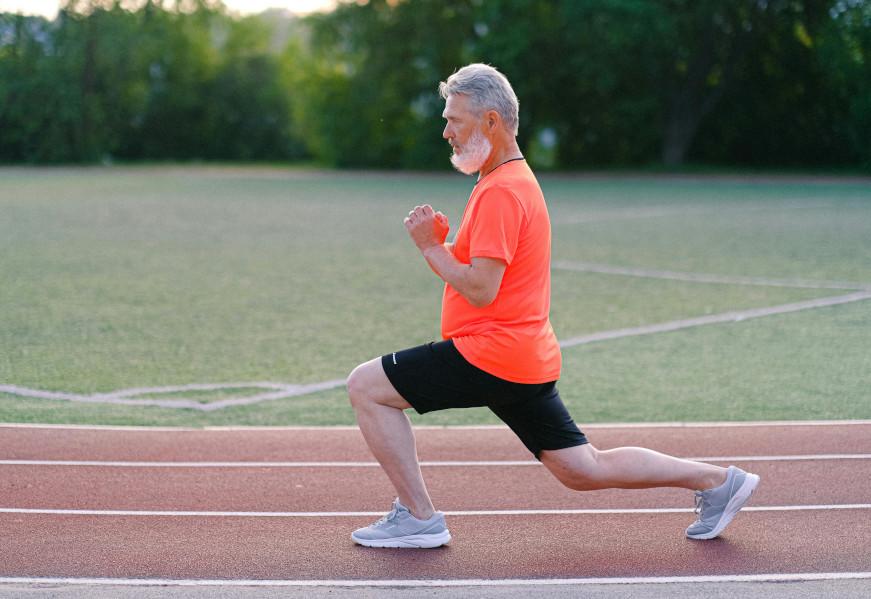Maintaining balance and stability is crucial for seniors to ensure safety, enhance mobility, and improve quality of life. As individuals age, their muscle strength, flexibility, and proprioception – the body’s ability to sense movement and position – can decline. These changes often lead to a decrease in balance, making older adults more susceptible to falls and related injuries. Incorporating balance stretches into daily routines can significantly help seniors bolster their stability, increase their confidence in performing everyday activities, and reduce the risk of falls.
Balance stretches specifically designed for seniors target the muscles and systems that are essential for maintaining an upright and stable posture. Exercises such as standing marches, single-leg stances, and heel raises engage the core and lower body muscles that support balance. Moreover, these stretches can be modified to meet individual fitness levels, ensuring that all seniors, regardless of their current ability or mobility, can participate in improving their balance.
Implementing a series of balance stretches benefits seniors by not only minimizing the potential for falls but also by contributing to a more active and independent lifestyle. Simple, low-impact exercises that challenge one’s balance can be done at home with minimal equipment. Regular practice of these exercises can lead to noticeable improvements in coordination and proprioception, helping older adults navigate their environments more effectively and with greater assurance.
Understanding Balance in Seniors
In the aging process, maintaining balance becomes crucial for seniors to reduce fall risks and maintain independence. This section explores how balance functions, common issues that may arise, and the positive impacts of enhancing balance for the elderly.
The Role of Balance in Aging
Balance is the body’s ability to maintain its center of gravity within its base of support. As individuals age, they often experience a natural decline in balance and coordination. This is due to several factors including decreased muscle strength, joint flexibility, and potential deterioration in vision and proprioception, which is an individual’s sense of position and movement. Aging can also affect the vestibular system, responsible for sending signals to the brain about head and body movements relative to gravity.
Common Balance Challenges
Seniors frequently encounter balance challenges that can lead to increased fall risks. Health conditions such as arthritis can contribute to joint stiffness and pain, thereby affecting stability. Additionally, a decline in joint health can make it harder to maintain balance. Muscle weakness and slower reflexes are other common issues that can compromise an elderly person’s ability to recover from stumbles. Moreover, certain medications and their side effects can disturb balance, making coordination even more difficult.
Benefits of Improved Balance
Strength and stability in the elderly can lead to significant health benefits. By engaging in exercises that enhance balance, seniors can improve joint health, thus reducing joint stiffness and potentially alleviating some symptoms of arthritis. Improved balance also correlates with a reduced risk of falls, which are a leading cause of serious injury in seniors. With better balance, seniors can enjoy greater mobility and independence, which in turn can lead to enhanced overall well-being.
Key Balance and Stretching Exercises
Effective balance and stretching exercises are vital for seniors to maintain stability, coordination, and flexibility. Incorporating such exercises into a regular routine can aid in building strength and improving overall movement.
Static Balance Exercises
Static exercises are an excellent starting point for seniors working on their balance as they involve little movement and focus on holding a position.
- Tree Pose: Stand and shift weight onto one leg. Place the opposite foot against the standing leg’s inner thigh, keeping hips facing forward. Arms can extend upward like branches. Hold for 10-30 seconds and switch sides.
- Flamingo Stand: Lift one foot off the ground, holding onto a stable surface if needed. Stand on one leg to challenge stability, holding the position for up to 30 seconds before switching.
Dynamic Balance Exercises
Dynamic exercises involve movement and are crucial for improving coordination and muscle strength.
- Heel-to-Toe Walk: Place the heel of one foot directly in front of the toes of the other foot, as if walking on a tightrope, and walk forwards for 20 steps.
- Rock the Boat: Stand with feet hip-width apart. Shift weight to one side and lift the opposite foot off the ground slowly. Hold for a few seconds, return to start, and repeat on the other side.
Stretching for Flexibility
Flexibility exercises help maintain the range of motion, which is important for performing daily activities and preventing injuries.
- Calf Stretch: Stand at arm’s length from a wall, step one leg back, keep it straight with the heel on the floor. Lean into the wall until a stretch is felt in the back leg’s calf. Hold for 30 seconds, then switch.
- Tai Chi: Although not a single stretch, Tai Chi involves a series of movements that enhance flexibility and strength through flowing motions.
Safety Precautions and Fall Prevention
In ensuring safety for seniors, fall prevention is paramount, requiring an approach that encompasses both safe exercise practices and the tailoring of activities to individual needs. It’s crucial to align with professional advice from healthcare providers and to foster confidence through structured programs.
Safe Exercise Practices
When seniors engage in balance exercises, they must adopt safe exercise practices. Firstly, they should always begin with a warm-up to gently prepare muscles and joints for activity. It is advisable to exercise in a hazard-free area to minimize the risk of tripping or slipping. Keeping a sturdy chair or a handle within reach can provide additional support during exercises.
- Consultation with a Doctor: Before starting any new exercise regimen, seniors should consult their doctor to ensure the activities are appropriate for their health status.
- Proper Footwear: Wearing supportive, non-slip shoes can significantly reduce the risk of falls.
- Gradual Progression: Starting with simple exercises and gradually increasing difficulty helps build strength and balance without overwhelming the body.
Adapting Exercises for Better Safety
Adapting exercises to suit an individual’s capabilities is a key to preventing falls. Seniors might require exercises that are modified to meet their physical conditions.
- Seated Exercises: For those with limited mobility, beginning with seated exercises can provide stability and reduce the risk of falling.
- Environment: Maintaining an uncluttered space with good lighting can help in preventing accidental trips or falls during exercise.
- Assistance: Utilizing the help of a caregiver or physical therapist when attempting new exercises can increase safety and build confidence.
In summary, seniors should prioritize fall prevention by adopting safe exercise practices and adjusting activities to fit their safety needs, all under the guidance of healthcare professionals.
Incorporating Strength Training
Strength training plays a crucial role in maintaining balance, as it reinforces the core and leg muscles that are pivotal for stability. By engaging in simple exercises, seniors can significantly enhance their posture and reduce the risk of falls.
Importance of Core and Leg Strength
Strong core muscles are fundamental for balance and stability. These muscles support the torso, where much of the body’s center of gravity is located. Efficient strength training focuses on the core to maintain an upright and stable posture.
Leg strength is equally significant as it provides the power needed for motion and aids in maintaining balance during movement. Stronger legs also contribute to a more secure base, which is essential for the various movements seniors perform in daily life, such as walking, climbing stairs, and getting out of a chair.
Simple Strength Training Exercises
For seniors looking to bolster their core and leg muscles, the following exercises are helpful and can be performed safely with minimal equipment:
- Back Leg Raises: To fortify the lower back and buttocks
- Stand behind a chair, holding on for balance.
- Slowly lift one leg straight back without bending the knee.
- Hold the position for a moment, then gently bring the leg back down.
- Squats: To enhance leg strength, focusing on the quadriceps, hamstrings, and calf muscles
- Stand with feet hip-width apart, either unassisted or using a chair for support.
- Bend the knees while keeping the back straight, as if sitting back into a chair.
- Lower down as far as comfortable, then push back up to standing.
Incorporating these simple exercises into a regular routine can significantly contribute to a senior’s strength, balance, and overall well-being.
Balance Equipment and Props
In the realm of balance exercises for seniors, both everyday household items and specialized equipment can be utilized to create effective workout routines. These tools are beneficial in enhancing stability and reducing the risk of falls.
Utilizing Everyday Objects
Seniors can leverage objects commonly found at home to support their balance workouts. A sturdy chair can serve as a steady handhold for standing exercises or as a base for seated movements. For those who require additional stability, walls provide a firm surface to lean on during exercises such as side leg raises. Meanwhile, a non-slip yoga mat ensures safe footing while engaging in ground-based stretches and poses.
| Everyday Object | Function |
|---|---|
| Chair | Handhold for standing exercises |
| Wall | Support for stability during stretches |
| Yoga Mat | Non-slip surface for ground exercises |
Specialized Equipment for Balance
For individuals looking to enhance their balance training, specific equipment can offer additional benefits. Balance boards introduce a dynamic element to workouts, challenging one’s proprioception and core strength. Tailored specifically to the needs of seniors, such tools can be incorporated progressively to accommodate varying levels of ability.
- Balance Board: Improves coordination and core strength.
- Wobble Cushion: Provides unstable surface to engage stabilizing muscles.
- Balance Balls: Useful for seated balance workouts and core engagement.
Remember that safety should always be a priority. Seniors should ensure that the equipment is placed on a stable surface and should consider having support nearby when attempting new exercises.
Creating a Balanced Exercise Routine
For seniors aiming to enhance their balance and stability, a well-structured exercise routine is essential. It combines targeted balance exercises with adequate scheduling to maximize the benefits of physical activity.
Combining Exercises for Optimal Benefits
A balance program for seniors should incorporate exercises that challenge stability while promoting overall fitness. Walking is a fundamental activity that improves gait and leg strength. In addition to walking, a senior’s routine can include:
- Single-leg stance: Improves core stability and leg strength.
- Heel-to-toe walks: Enhances coordination and balance.
- Standing marches: Increases hip flexibility and balance.
- Lateral stepping: Strengthens the side muscles of the hips and legs.
These exercises should be performed in a circuit, allowing each movement to complement the others for improved effectiveness.
Routine Scheduling and Breaks
Consistency is key in any fitness routine. Seniors should aim to engage in balance and strength exercises on most days of the week. A typical routine could include:
- Monday: Balance exercises (20 minutes)
- Wednesday: Walking (30 minutes) and light strength training (15 minutes)
- Friday: Balance exercises (20 minutes) and walking (30 minutes)
It’s important to listen to one’s body and include breaks. Adequate rest periods between exercises—especially if fatigue or discomfort occurs—are crucial to prevent overexertion and injuries. This not only maximizes the benefits of the workout but also ensures long-term adherence to the routine.
Adapting to Physical Limitations
When creating an exercise program for seniors with physical limitations, it’s essential to tailor stretches and balance exercises to individual abilities and health conditions. This ensures safety, maximizes benefits, and helps prevent pain or injury.
Exercises for Different Ability Levels
To address the diverse abilities of seniors, exercises can be categorized based on the level of support they require.
- Seated Exercises: Ideal for those with limited mobility, exercises such as seated leg extensions and ankle circles help improve flexibility in a safe, stable position.
- Standing Exercises with Support: Using a chair or wall for balance, one can perform standing calf stretches or shoulder rolls, promoting both flexibility and stability.
- Independent Standing Exercises: For those with more confidence in their balance, hamstring stretches and gentle weight shifts improve both flexibility and leg strength.
It’s important to start with the level that meets one’s current ability and gradually progress as strength and balance improve.
Modifying for Health Conditions
Adaptations for specific health conditions ensure that seniors can safely participate in balance exercises without exacerbating their symptoms.
- Cardiovascular Disease: Seniors with cardiovascular disease should opt for low-intensity stretches and should have clearance from a healthcare provider before beginning any new exercise routine.
- Migraine Sufferers: For those prone to migraines, slow, controlled movements are crucial to avoid triggering headaches.
- Injury or Pain Recovery: If recovering from injuries or persistent pain, one should focus on gentle stretching within a pain-free range to enhance recovery without causing further damage.
By customizing balance exercises and stretches to individual needs and conditions, seniors can safely improve their flexibility and stability, supporting overall well-being and quality of life.
Enhanced Well-being Through Balance Training
Balance training is essential for seniors as it not only improves physical stability but also contributes to better mental health and overall well-being. This type of exercise, when practiced regularly, can lead to significant benefits, including improved confidence and stress relief, positively impacting one’s quality of life.
Mental Health Benefits
Balance training can help seniors combat stress and anxiety, leading to improved mental health. The focus required during balance exercises can divert the mind from daily worries, promoting a state of mindfulness. Moreover, the achievement of maintaining balance during exercises can bolster confidence, which in turn has a positive effect on mental well-being.
Long-Term Effects on Well-being
The commitment to regular balance training can generate long-term enhancements in quality of life for seniors. Studies suggest that ongoing practice can reduce the risk of falls—increasing autonomy and further reinforcing self-assurance. Furthermore, the physical activity involved in balance training stimulates the release of endorphins, which are natural stress-fighters, fostering a sense of happiness and satisfaction.








